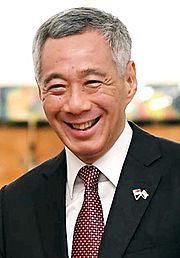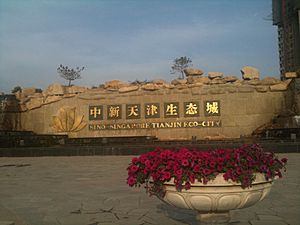Lee Hsien Loong facts for kids
Quick facts for kids
Lee Hsien Loong
PPA(E) SPMJ DK
|
|
|---|---|
| 李显龙 | |
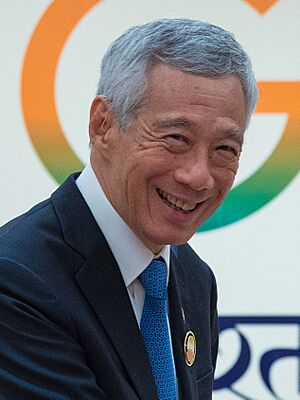
Lee at the 2023 G20 New Delhi summit
|
|
| Senior Minister of Singapore | |
| Assumed office 15 May 2024 Serving with Teo Chee Hean (2019–2025)
|
|
| Prime Minister | Lawrence Wong |
| Preceded by | Tharman Shanmugaratnam |
| 3rd Prime Minister of Singapore | |
| In office 12 August 2004 – 15 May 2024 |
|
| President | S. R. Nathan Tony Tan< Halimah Yacob Tharman Shanmugaratnam |
| Deputy | Tony Tan S. Jayakumar Wong Kan Seng Teo Chee Hean Tharman Shanmugaratnam Heng Swee Keat Lawrence Wong |
| Preceded by | Goh Chok Tong |
| Succeeded by | Lawrence Wong |
| Secretary-General of the People's Action Party | |
| In office 7 November 2004 – 4 December 2024 |
|
| Chairman | Tony Tan Lim Boon Heng Khaw Boon Wan Gan Kim Yong Heng Swee Keat |
| Preceded by | Goh Chok Tong |
| Succeeded by | Lawrence Wong |
| Member of the Singapore Parliament for Ang Mo Kio GRC |
|
| Assumed office 31 August 1991 |
|
| Preceded by | Constituency established |
| Majority |
|
| Member of the Singapore Parliament for Teck Ghee SMC |
|
| In office 22 December 1984 – 14 August 1991 |
|
| Preceded by | Constituency established |
| Succeeded by | Constituency abolished |
| Majority |
|
| Chairman of the Monetary Authority of Singapore | |
| In office January 1998 – August 2004 |
|
| Preceded by | Richard Hu |
| Succeeded by | Goh Chok Tong |
| Deputy Prime Minister of Singapore | |
| In office 28 November 1990 – 12 August 2004 Serving with Ong Teng Cheong (1985–1993)
Tony Tan (1995–2004) |
|
| Prime Minister | Goh Chok Tong |
| Preceded by | Goh Chok Tong |
| Succeeded by | S. Jayakumar |
| Minister for Finance | |
| In office 10 November 2001 – 1 December 2007 |
|
| Prime Minister | Goh Chok Tong Himself |
| Second Minister | Lim Hng Kiang Raymond Lim Tharman Shanmugaratnam |
| Preceded by | Richard Hu |
| Succeeded by | Tharman Shanmugaratnam |
| Minister for Trade and Industry | |
| In office 1 January 1987 – 6 December 1992 Acting: 18 February 1986 – 31 December 1986 |
|
| Prime Minister | Lee Kuan Yew Goh Chok Tong |
| Preceded by | Tony Tan |
| Succeeded by | S. Dhanabalan |
| Second Minister for Defence (Services) |
|
| In office 1 January 1987 – 27 November 1990 Serving with Yeo Ning Hong (Policy)
|
|
| Prime Minister | Lee Kuan Yew |
| Minister | Goh Chok Tong |
| Personal details | |
| Born | 10 February 1952 Singapore |
| Political party | People's Action Party |
| Spouses |
Wong Ming Yang
(m. 1978; died 1982)Ho Ching
(m. 1985) |
| Children | 4; including Li Hongyi |
| Parents | Lee Kuan Yew (father) Kwa Geok Choo (mother) |
| Relatives | Lee Hsien Yang (brother) Lee Wei Ling (sister) |
| Alma mater | Trinity College, Cambridge (BA, Dipl.) Harvard University (MPA) |
| Occupation | Politician, military officer |
| Signature | |
| Military service | |
| Branch/service | Singapore Army |
| Years of service | 1971–1984 |
| Rank | Brigadier-General |
| Commands | Director of the Joint Operations and Planning Directorate Chief of Staff – General Staff Assistant Chief of the General Staff (Operations) Commanding Officer, 23rd Battalion Singapore Artillery |
| Lee Hsien Loong | |||||||||||||||||||||||||
|---|---|---|---|---|---|---|---|---|---|---|---|---|---|---|---|---|---|---|---|---|---|---|---|---|---|

Lee's name in Simplified (top) and Traditional (bottom) Chinese characters
|
|||||||||||||||||||||||||
| Chinese | 李显龙 | ||||||||||||||||||||||||
| Traditional Chinese | 李顯龍 | ||||||||||||||||||||||||
| Simplified Chinese | 李显龙 | ||||||||||||||||||||||||
|
|||||||||||||||||||||||||
Lee Hsien Loong (born 10 February 1952) is a Singaporean politician and former military officer. He was the third Prime Minister of Singapore from 2004 to 2024. After that, he became a Senior Minister of Singapore. He was also the leader of the People's Action Party (PAP) from 2004 to 2024. He has been a Member of Parliament (MP) for Ang Mo Kio GRC since 1991. Before that, he was an MP for Teck Ghee SMC from 1984 to 1991.
Lee was born and grew up in Singapore when it was a British colony. He is the oldest son of Lee Kuan Yew, Singapore's first prime minister. He studied mathematics at Trinity College, Cambridge, and also earned a diploma in computer science. He served in the Singapore Armed Forces (SAF) from 1971 to 1984, reaching the rank of Brigadier-General. He also earned a Master's degree in Public Administration from Harvard University. Lee left the military in 1984 to start his political career.
Before becoming prime minister, Lee held several important government jobs under prime ministers Lee Kuan Yew and Goh Chok Tong. He became prime minister in August 2004. During his time as prime minister, he introduced many changes. These included a five-day work week and longer maternity leave. He also supported building two large resorts to attract more tourists. After the Great Recession in 2008, he helped Singapore's economy recover quickly. His government also made changes to political rules, like increasing the number of non-elected Members of Parliament.
From 2020 to 2021, Lee led Singapore's response to the COVID-19 pandemic. In 2022, his government also responded to the Russian invasion of Ukraine, making Singapore the only Southeast Asian country to place sanctions on Russia. That same year, his government removed an old law, Section 377A, which had criminalized certain private acts between consenting adults. In April 2024, Lee announced he would step down as prime minister. Lawrence Wong took over as prime minister on 15 May 2024, and Lee became a Senior Minister.
Lee's time as prime minister was known for keeping Singapore politically stable and well-managed. He made gradual changes to policies, like improving social support and public housing to help with inequality. However, some people criticized the government's control over public discussions. His government also used laws like the Protection from Online Falsehoods and Manipulation Act (POFMA) to deal with online misinformation.
Contents
- Early Life and Education
- Starting a Political Career
- Deputy Prime Minister
- Prime Minister (2004–2024)
- Senior Minister (2024–present)
- Singapore's Relationships with Other Countries
- Personal Life
- Honours and Awards
- See also
Early Life and Education
Lee Hsien Loong was born in Singapore on 10 February 1952. He is the oldest child of Lee Kuan Yew and Kwa Geok Choo. His family has roots in China.
Schooling and University Studies
Lee went to Nanyang Primary School and Catholic High School. He played the clarinet in the school band. He then attended National Junior College. In 1971, he received scholarships to study mathematics at Trinity College, Cambridge, in the United Kingdom.
He was a top student at Cambridge, graduating in 1974 with high honors in mathematics. He also earned a diploma in computer science. His teachers described him as a very bright mathematician. Later, in 1980, he earned a Master's degree in Public Administration from Harvard University in the United States. Lee has said he does not regret choosing politics over mathematics, feeling it was his duty to help Singapore succeed.
Military Service
Lee joined the Singapore Armed Forces (SAF) in 1971. He served as an officer from 1974 to 1984. He held various important roles, including Director of Joint Operations and Chief of Staff.
He also attended the United States Army Command and General Staff College in 1978. Lee quickly rose through the ranks, becoming the youngest brigadier-general in Singapore's history at age 32 in 1983. He led rescue operations during the Sentosa cable car disaster. He left the SAF in 1984 to enter politics.
Starting a Political Career
In the 1980s, Lee was seen as a key figure for the next generation of leaders in the People's Action Party (PAP). This was because Lee Kuan Yew had announced he would step down as prime minister in 1984.
Lee was first elected as a Member of Parliament for Teck Ghee SMC in 1984, when he was 32. He was then appointed Minister of State for Trade and Industry, and Minister of State for Defence.
In 1985, Lee led a government committee that suggested changes to help Singapore's economy, which was facing a recession. The committee recommended lowering taxes and introducing a consumption tax. In 1987, he became a full Cabinet member as Minister for Trade and Industry and Second Minister for Defence.
Youth Leadership in the PAP
In 1986, Lee helped set up the PAP Youth Committee, which later became Young PAP. This group was created to encourage younger Singaporeans to join the party and share their ideas. It aimed to give new members a way to contribute to the country's future.
Deputy Prime Minister
On 28 November 1990, Goh Chok Tong became prime minister. Lee Hsien Loong was appointed one of two deputy prime ministers. He continued as Minister for Trade and Industry until 1992.
In 1992, Lee was diagnosed with lymphoma, a type of cancer. He stepped down from his ministerial position to undergo three months of chemotherapy. He remained a deputy prime minister during this time. The treatment was successful, and his cancer went into remission.
Lee became chairman of the Monetary Authority of Singapore (MAS) in January 1998. In 2001, he was made Finance Minister. To help with the government's budget, he suggested raising the GST from three percent to five percent in 2003. This change happened in January 2004.
Lee also made it easier for foreign-born children of Singaporean women to become Singapore citizens. These changes were made after many requests from Members of Parliament.
Prime Minister (2004–2024)
First Years as Prime Minister (2004–2006)
On 12 August 2004, Lee became Prime Minister, taking over from Goh Chok Tong. He also became chairman of the People's Association.
In his first major speech as prime minister in August 2004, Lee announced new plans. One important change was the "five-day work week," which removed the half-working day on Saturday. This started in January 2005. Maternity leave was also made longer to help families. To encourage more births, the Baby Bonus scheme was expanded.
In November 2004, Lee suggested building two large Integrated Resorts (IRs), which include hotels and casinos. Even though Singapore had been against gambling, the government felt it was important to attract more tourists. In April 2005, the plan was approved. These resorts were built in Marina Bay and Sentosa. To prevent gambling problems, safeguards were put in place, like charging an entrance fee for Singaporeans.
In February 2006, Lee announced a "Progress Package" to share government budget surpluses with citizens. This included cash, top-ups to retirement funds, and education funds.
Second Term and Economic Challenges (2006–2011)
In the 2006 general election, Lee's party, the PAP, won most of the seats. Lee and his team won their constituency, Ang Mo Kio GRC.
In November 2007, Lee handed over his role as Finance Minister to Tharman Shanmugaratnam. This was seen as a good move, allowing a dedicated minister to focus on Singapore's role as a financial hub.
The Great Recession
Singapore's economy grew for the first two years of Lee's leadership, but then faced a big challenge during the Great Recession in 2008. Singapore was the first Asian country to enter a recession. The government responded with large financial packages to help businesses and keep unemployment low.
By August 2009, Lee announced that the worst was over. Singapore's economy recovered strongly, with record growth in 2010.
Changes to Political System
In 2010, Lee introduced changes to Singapore's electoral system. These changes included reducing the number of large group constituencies and increasing the number of non-elected Members of Parliament. A "cooling-off day" was also introduced before elections, where campaigning is not allowed.
Third Term and New Challenges (2011–2015)
In the 2011 Singapore general election, the PAP won, but with a lower percentage of votes than usual. This was seen as a sign of public concerns about issues like immigration and the cost of living. The PAP lost one group constituency, Aljunied GRC, to the opposition Workers' Party. After the election, Lee Kuan Yew and Goh Chok Tong stepped down from the Cabinet to allow for new leaders. Lee was sworn in for his third term on 21 May 2011.
In 2012, Lee mentioned that he hoped to step down as prime minister before he turned seventy.
Fourth Term and Global Events (2015–2020)
In the 2015 Singapore general election, Lee was re-elected, and the PAP won a strong victory. Lee's fourth term saw global events like the China–United States trade war, which affected Singapore's economy. There were also more cyberattacks, leading to new laws and agencies to improve cybersecurity.
Singapore also hosted important international meetings, such as the Ma–Xi meeting between leaders from Mainland China and Taiwan in 2015, and the North Korea–United States summit in 2018. Singapore also hosted the signing of the Singapore Convention on Mediation in 2019, a United Nations treaty.
In 2018, Lee's health data, along with that of many other residents, was accessed in a cyberattack. The attackers specifically targeted Lee's information.
In April 2019, Lee made changes to his cabinet, promoting Heng Swee Keat to Deputy Prime Minister. This was seen as a step towards Heng becoming the next prime minister.
Planned Tax Increase
In 2017, Lee said that raising taxes was necessary to fund important areas like social services, healthcare, and infrastructure. The GST was expected to increase from 7% to 9% by 2025. This increase was planned to pay for rising costs, especially in healthcare for an ageing population.
Dealing with Online Misinformation
Lee's government introduced the Protection from Online Falsehoods and Manipulation Act (POFMA) in 2018. This law, sometimes called the "fake news law," aims to prevent the spread of false information online. Some groups expressed concerns that the law might limit free speech. However, Lee and his ministers stated that the law was necessary to prevent false information from disrupting society. They explained that free speech has limits and that harmful or threatening speech should be restricted.
Response to the COVID-19 Pandemic
The first COVID-19 case in Singapore was confirmed in January 2020. As cases grew, especially among foreign workers, Lee announced a limited lockdown called a "circuit breaker" in April 2020. Workplaces were closed, and schools switched to home-based learning. Lee's government also provided several financial support packages to help the economy during the pandemic.
Fifth Term and Transition (2020–2024)
After the 2020 Singapore general election, Lee was re-elected, and the PAP won the majority of votes. However, the opposition Workers' Party gained more seats. Lee acknowledged the public's desire for more debate and appointed Pritam Singh as the first official Leader of the Opposition.
Lee had planned to retire around his 70th birthday in 2022, but he delayed this due to the demands of the COVID-19 pandemic. In August 2022, Lee announced that his government would remove Section 377A of the Penal Code, which had criminalized certain private acts between consenting male adults. This was a significant step for the LGBT community in Singapore.
In August 2023, Lee indicated that Lawrence Wong was his likely successor as prime minister. On 5 November 2023, Lee announced he would hand over the role of prime minister to Lawrence Wong by November 2024. The handover happened on 15 May 2024.
Senior Minister (2024–present)
Lee resigned as prime minister on 13 May 2024. He was then appointed as a Senior Minister by the new prime minister, Lawrence Wong, on 15 May 2024. He also continues to chair the Research, Innovation and Enterprise Council.
Singapore's Relationships with Other Countries
China
Singapore has worked closely with China on large government projects, like the Suzhou Industrial Park and the Tianjin Eco-City. The China-Singapore Free Trade Agreement, which was the first for an Asian country with China, was updated in 2018. Singapore has also been a big investor in China's "Belt and Road" Initiative. China has been Singapore's largest trading partner since 2013.
Relations between the two countries have been strong. Singapore follows the "One-China policy," which means it recognizes only one China. However, relations became a bit tense in 2016 when Singapore supported a ruling about the South China Sea that went against China's claims. In November 2016, Hong Kong authorities seized Singaporean military vehicles that were returning from training in Taiwan. This incident was seen as a warning to Singapore. The vehicles were returned in January 2017. Since then, Singapore has worked to improve relations with China, signing a defense agreement in 2019.
United States
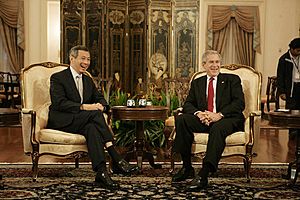
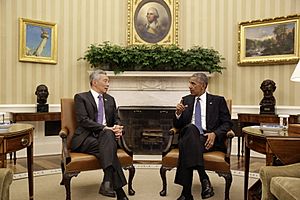
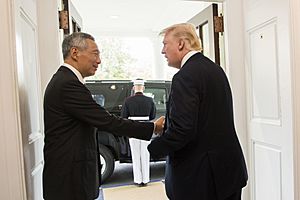

Singapore has a close relationship with the United States, especially in defense. The US provides many weapons to Singapore. Singapore sees the US as important for stability in Asia. Lee's government has continued this policy, seeing the US as a balance to China's growing power.
The two countries have a defense agreement from 1990, which allows the US to use Singapore's air and naval bases. In 2005, Lee and President George W. Bush signed an agreement to work together on security. This agreement was updated in 2015 to include cooperation on cyber defense and disaster relief. US surveillance planes have also been based in Singapore. Singapore has also supported US military actions against ISIS. In 2019, Lee and the Donald Trump administration renewed the defense agreement for another 15 years.
The United States is the largest foreign investor in Singapore. The Singapore-United States Free Trade Agreement started in 2004, leading to significant trade between the two countries. Lee was a strong supporter of the Trans-Pacific Partnership, a trade agreement aimed at reducing trade barriers. He urged the US to ratify the deal, saying it would affect US standing in the world. However, the US later withdrew from the agreement.
Malaysia
Malaysia has had several prime ministers and government changes since Lee became prime minister in 2004. Lee has worked to improve relations with Malaysia by increasing economic ties and transport links. Since 2010, Lee has attended annual meetings with Malaysian leaders to discuss issues and resolve disputes. However, there are still occasional disagreements over things like water supply, land reclamation, and airspace. Both countries try to keep these disputes separate from cooperation on issues like crime and terrorism.
In 2007, Lee agreed to invest in the Iskandar Malaysia project, a tourism and industrial zone in Malaysia. In 2010, Lee and Prime Minister Najib Razak resolved a long-standing dispute over railway land. Singapore also handed over two water treatment plants to the Johor state government in 2011. To ease traffic on the Johor–Singapore Causeway, Lee revived plans to link Singapore's MRT network to Johor Bahru in 2011. Plans for a Kuala Lumpur–Singapore high-speed rail (KL-SG HSR) and a Johor Bahru-Singapore Rapid Transit System (JB-SG RTS) were also agreed upon.
After the 2018 Malaysian general election, the new Malaysian government delayed the rail projects due to high costs. Lee emphasized that the projects were legally binding but agreed to Malaysia's request for an extension. In October 2018, tensions rose over maritime and airspace claims. However, in April 2019, transport ministers from both countries reached an agreement to return to the previous arrangements. Singapore has continued to work closely with Malaysia to combat the COVID-19 pandemic. In July 2020, Lee and Prime Minister Muhyiddin Yassin formally agreed to restart the JB-SG RTS project.
In May 2022, Lee visited the Malaysian state of Johor and received a state award. He made another visit to Johor in January 2024 for the RTS Link project and to sign an agreement for the Johor-Singapore Special Economic Zone (JS-SEZ).
Personal Life
Lee married his first wife, Wong Ming Yang, in 1978. They had a daughter and a son. Sadly, Wong died of a heart attack in 1982.
Lee remarried in 1985 to Ho Ching, who later became the CEO of Temasek Holdings. They have two sons. Their elder son, Li Hongyi, works for the Government Technology Agency. Their younger son, Li Haoyi, is a software engineer.
Lee was diagnosed with lymphoma in the early 1990s and underwent successful treatment. In 2015, he had surgery for prostate cancer, which was also successful. Lee enjoys computer programming and has even written a Sudoku solver in his free time.
Honours and Awards
National Honours
Foreign Honours
 Brunei :
Brunei :
 Japan :
Japan :
 Grand Cordon of the Order of the Rising Sun, bestowed 29 April 2025.
Grand Cordon of the Order of the Rising Sun, bestowed 29 April 2025.
 Malaysia :
Malaysia :
 Peru :
Peru :
Awards
 International Olympic Committee :
International Olympic Committee :
- Olympic Order (Gold), conferred 13 August 2010.
See also
 In Spanish: Lee Hsien Loong para niños
In Spanish: Lee Hsien Loong para niños
- Government of Singapore
- Politics of Singapore


